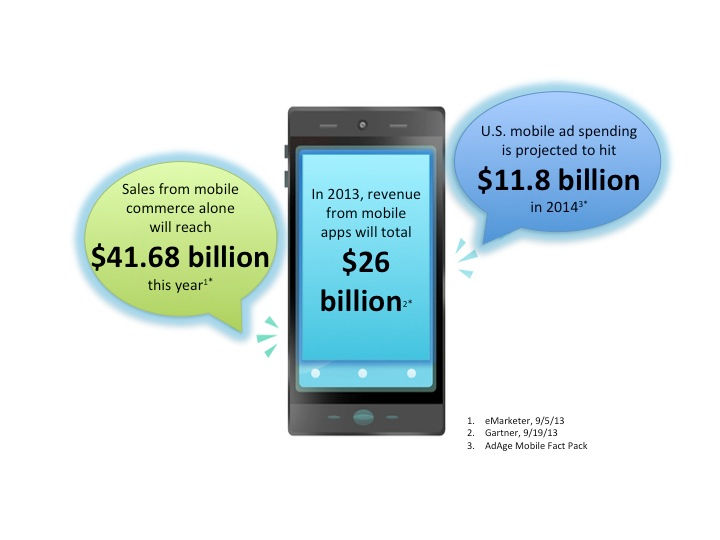Mobile Trends By The Numbers, Just In Time For The Holidays
- Fahad H

- Nov 7, 2013
- 3 min read
Mobile is on the minds of brands and consumers everywhere. Innumerable stats point to the rise of mobile and the subsequent changes in consumer behavior. Consumers are quickly re-shaping the way brands connect to their audiences as they take hold of the multi-screen world.
With the holiday season just around the corner and a new year upon us, marketers need to make sure they are “in the know” regarding the latest mobile trends, so they can make sure their campaigns are ready.
Mobile By The Numbers
Here are some key 2013 stats pointing to the rise of mobile and the shift in consumer activity:
According to the IAB, the first half of 2013 saw US advertisers spend $3 billion on mobile advertising, up from $1.2 billion just one year earlier. For the year ahead, U.S. mobile ad spending is projected to hit $11.8 billion in 2014.
Close to 50% of worldwide Internet consumers are using mobile devices as their primary mechanism for surfing the Web.
Sales from mobile commerce alone will reach $41.68 billion this year. By 2017, retail sales made on mobile devices will climb to well over $100 billion.
In 2013, retail purchases conducted on smartphones will net a total-sales revenue of $14.59 billion. By 2017, this figure will more than double to $30.66 billion.
In 2013, revenue attributable to mobile apps will total $26 billion, up nearly 70% from $18 billion in 2012.
Rise Of Mobile Commerce
It’s no secret that the explosive growth of e-commerce is impacting traditional retailers. Not having a mobile-optimized website for your brand has the revenue impact equivalent to closing your store one day per week.
More and more consumers are turning to their smart phones and tablets to research products showcased by television and mobile ads. Even more consumers are bypassing stores entirely, especially when most products are just one click away.
With mobile payment systems offering one-click purchasing across most major e-commerce platforms, it makes you wonder why anyone would choose to wait in a long line ever again.

Changes In Purchase Behavior
Mobile is changing the way everyone does business, period. This holiday season, advertisers will drive engagement and purchase intent with custom messaging based on interests and even geo-location as mobile ad dynamics vastly improve.
Social media will provide relevant purchase recommendations and customized user experiences via social plug-ins offered by major mobile shopping apps and search engines. Twitter and Facebook, in particular, will continue to factor largely into shaping new consumer habits, while remaining strong drivers of brand engagement and purchase intent through new retargeting offerings and creative formats such as Newsfeed ads.
To stay relevant within their mobile consumer base, there is a checklist of non-negotiable items advertisers absolutely need to follow. First is making sure users have easy access to a simple-to-use, mobile-optimized website — all the better if the site comes with a corresponding mobile app. Advertisers can even monetize their mobile apps by offering incentives and providing exclusive sales deals upon download.
The second requirement is to promote brand engagement across all media, including social, mobile and traditional. With multi-screen interaction on the rapid rise, it’s increasingly crucial that advertisers are visible everywhere their users are looking. Remember, it’s not about replacing other channels with mobile — it’s about leveraging mobile as an additional channel to amplify your brand and assist in driving conversions.
Targeting The Multi-Channel Consumer
Marketers can now bask in the glory of even better mobile targeting capabilities — including the availability of retargeting on Facebook, whose announcement hit the digital ad industry just before the holiday season. Marketers can now retarget users across Facebook mobile, providing advertisers a golden opportunity to capitalize on the multi-channel consumer.
This new feature (“Website and Mobile App Custom Audiences“) will include the same features as Facebook’s traditional custom audiences (age, gender, location, interests); additionally, it will allow marketers to pair proprietary data with related Facebook profiles. Advertisers can also retarget their brand’s mobile app users based on app installs and time last used, offering a new way of engaging with a brand’s user base while promoting mobile app adoption.
Your Mobile Marketing Strategy
We should expect new shockwaves in the way product information is disseminated, how purchases are conducted and how brand loyalty is cultivated throughout this holiday season and well into the New Year.
Keep a look out for new mobile ad formats and targeting capabilities across top social media networks; and most importantly, make sure your marketing strategy includes a strong mobile component to attract today’s multi-screen consumer.








Comments